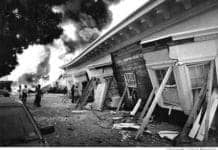by Carol Harvey

On Treasure Island May 28 and 29, 2015, the earth trembled and shook in a fenced-off location between the Island Cove Market and the Starburst Barracks. Engineers from Lennar’s vibro-compaction geotechnical subcontractor, Jafec USA, repeatedly sank four huge vibrating shafts 50 feet deep into Treasure Island fill, testing for the effect on the soil, groundwater and mud of the man-made island.
During a previous Wednesday, May 20, 2015, community meeting, Treasure Island Development Authority Director Robert Beck announced that, in preparation for Treasure Island redevelopment, Lennar Corp. would attempt a geological test that would shake down and compress loose fill. The idea is to prevent liquefaction by creating a powerful pulse with vibro-compaction bores that force loose soil particles together into a tighter mass.
Jafec USA was subcontracted by Lennar to conduct these vibro-compaction tests. Lennar’s planned next step in the process is to compact the soil with enormous pounders.
It is hoped that compacted soil will resist liquefaction, preventing buildings from collapsing in earthquakes. Redevelopment highrises then could be safely constructed and remain solidly anchored.
Vibro-compaction process on Treasure Island
Standing on the shaking ground, one fascinated islander said, “None of us think this is going to work.” More such tests will be conducted in the near future.
New sinkholes refute island pipeline integrity
Treasure Island is built from unstable landfill with 65- to 70-year-old pipes running through it. If you pierce the ground 50 feet down with a vibrating bore, will old pipes without integrity crack? Are they already cracked?
Can any geological action in the ground – like vibrating bores or earthquakes – cause nearly century-old pipes to crack faster or the loose landfill dirt to fall into sinkholes? Several sinkholes and foul-smelling puddles probably laced with sewage that appeared on the island soon after the boring created the suspicion that this probably happened.
It was no surprise that shortly after the May 29 and 30, 2015, compaction test and boring, the spray-painted words “cracked pipes” appeared about a block away from the boring site on the sidewalk behind the Starburst Barracks. Additionally, a series of sinkholes formed in a line along the moist earth on the pathway next to the Job Corps fence above apparently leaking pipelines.

Islanders walk every inch of this small island daily. Residents are familiar with every dirt pile and environmental alteration on Treasure Island. Despite yellow radiation warning signs, people squeeze through huge gaps in exclusion zone fences.
Sinkholes and broken pipes
On Wednesday, July 1, 2015, Treasure Island resident Liz Washington showed me two sinkholes that appeared connected at either end of a large, shallow 5-foot-long depression in the asphalt parking lot next to the Starburst Barracks. The indentation’s end closest to Ninth Street was deep and contained a pool of water.
Walking east away from Ninth to the groove’s opposite end near the barracks, Liz gestured with her foot. “A new (sinkhole) is beginning to form,” she said. Perhaps to hide or plug the sinkhole, this end had been paved over with concrete.
We continued walking east for about a block behind the Star Barracks toward the Island Cove Market. Next to the wooden fence separating the federal Job Corps grounds from City land, we came upon a large, slightly caved-in circle in the dirt with a third drain at its center.
Two weeks previously, at that spot, Liz’s daughter had photographed a deep sinkhole next to the drain cover. It was encircled with yellow police tape. The words, “Broken pipes,” were spray painted in white next to the hole. By the time we got there – as if to conceal the evidence – the sinkhole she documented had been paved over with asphalt.
Was this sinkhole caused by the vibrating bore?
Stinky puddles
Three weeks after the May 29 boring test, another long-term island resident, Andrea McHenry, announced to the community and the Navy at the public June 17 Restoration Advisory Board meeting that, immediately after the bores were sunk, the same foul smells and sewage puddles appeared on the old elementary school and abandoned Boys and Girls club facility playground whose old basketball nets are still being used by island youth.
McHenry reported that on Treasure Island’s Next Door social network website, “just a couple weeks ago during the pounding, people were saying that there’s sewage coming up in the school yard” from the ground, “and stinky puddles. And people’s water coming out of their faucets – brown.” Another Island resident reported seeing an additional sinkhole on the large playground across Avenue E from the school.
Featuring Andrea McHenry testifying at the RAB meeting
This series of sinkholes across several City blocks stretched from the elementary school yard at Site 31 all the way to Ninth Street and along the dirt pathway behind the Starbust Barracks to the Island Cove Market – that’s half the island’s width. My Treasure Island companion, Liz Washington, and her daughter suspected that builder Lennar’s recent vibrating bore experiment next to the market may have been implicated in these cave-ins.
No bedrock
After the June 17, 2015, Restoration Advisory Board meeting, I reminded a Treasure Island environmental remediator of a Navy study after the Loma Prieta devastation that found the “stiff” clay layer at the bottom of the Bay vulnerable to seismic events. I asked how he thought Lennar would build highrises on the island. Off the record, he told me he thought there was bedrock under the silt, mud and clay, and they would sink shafts into bedrock.
I talked to CalTrans workmen building on-ramps into Treasure Island. I asked them whether there was bedrock under the Bay Bridge. They told me unequivocally that when they sank bores 260 feet down, they found no bedrock. Huge steel manmade anchors are lowered to a great depth through the mud, silt and clay layers. They said the Bay Bridge is stabilized on these anchors.
In the wake of Lennar’s vibro-compaction tests, the artificial island’s fill seems to be collapsing. Did the vibrating bore cause the sinkholes? Or perhaps the shaking shattered pipes released sewage or water, melting the dirt.
Considering Treasure Island soil’s fragility which caused it to sink a foot last year, it remains to be seen how Lennar plans to protect redevelopment structures from collapsing in the inevitable earthquake.
Carol Harvey is a San Francisco political journalist specializing in human rights and civil rights. She can be reached at carolharvey1111@gmail.com.

 Store
Store









